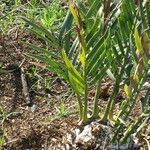Plant dioecious, palm-like. Stem aerial or decumbent, 0.5-2.5 m long, unbranched or branched from base, covered by alternating series of woody bracts and persistent, swollen, truncated leaf bases. Leaves petiolate, pinnate with rachis recurved; median leaflets, entire, pungent-pointed; reduced in size towards base of rachis. Cone Feb.-Dec., single, appears sessile, maroon or green. Male cone oblanceoloid. Female cone cylindric to ovoid, broader than male, facets glabrous, central facet not raised.
Dioecious tree to 2 m, often branched from base. Leaves pinnate, dark green but glaucous when young, leaflets linear-lanceolate, pungent, sometimes 1-or 2-toothed. Female cones green, to 50 cm.


